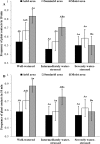Impact of water-deficit stress on tritrophic interactions in a wheat-aphid-parasitoid system
- PMID: 29053722
- PMCID: PMC5650152
- DOI: 10.1371/journal.pone.0186599
Impact of water-deficit stress on tritrophic interactions in a wheat-aphid-parasitoid system
Abstract
Increasing temperature and CO2 concentrations can alter tritrophic interactions in ecosystems, but the impact of increasingly severe drought on such interactions is not well understood. We examined the response of a wheat-aphid-parasitoid system to variation in water-deficit stress levels. Our results showed that arid area clones of the aphid, Sitobion avenae (Fabricius), tended to have longer developmental times compared to semiarid and moist area clones, and the development of S. avenae clones tended to be slower with increasing levels of water-deficit. Body sizes of S. avenae clones from all areas decreased with increasing water-deficit levels, indicating their declining adaptation potential under drought. Compared to arid area clones, moist area clones of S. avenae had a higher frequency of backing under severe water stress only, but a higher frequency of kicking under well-watered conditions only, suggesting a water-deficit level dependent pattern of resistance against the parasitoid, Aphidius gifuensis (Ashmead). The number of S. avenae individuals attacked by the parasitoid in 10 min showed a tendency to decrease with increasing water-deficit levels. Clones of S. avenae tended to have lower parasitism rates under treatments with higher water-deficit levels. The development of the parasitoid tended to be slower under higher levels of water-deficit stress. Thus, the bottom-up effects of water-deficit stressed plants were negative on S. avenae. However, the top-down effects via parasitoids were compromised by water-deficit, which could favor the growth of aphid populations. Overall, the first trophic level under water-deficit stress was shown to have an indirect and negative impact on the third trophic level parasitoid, suggesting that parasitoids could be increasingly vulnerable in future warming scenarios.
Conflict of interest statement
Figures





Similar articles
-
Life-history responses of insects to water-deficit stress: a case study with the aphid Sitobion avenae.BMC Ecol. 2018 May 29;18(1):17. doi: 10.1186/s12898-018-0173-0. BMC Ecol. 2018. PMID: 29843697 Free PMC article.
-
Impacts of Water Deficiency on Life History of Sitobion avenae Clones From Semi-arid and Moist Areas.J Econ Entomol. 2015 Oct;108(5):2250-8. doi: 10.1093/jee/tov210. Epub 2015 Jul 21. J Econ Entomol. 2015. PMID: 26453713
-
Responses of Sitobion avenae (Hemiptera: Aphididae) to water-deficit stress on drought-resistant wheat cultivars.J Econ Entomol. 2025 Jun 18:toaf091. doi: 10.1093/jee/toaf091. Online ahead of print. J Econ Entomol. 2025. PMID: 40577086
-
The arbuscular mycorrhizal fungus Claroideoglomus etunicatum (Glomerales: Claroideoglomeraceae) inoculated wheat plants mediated responses of Sitobion avenae (Fabricius) (Hemiptera: Aphididae) to water deficit.J Econ Entomol. 2025 Feb 11;118(1):203-218. doi: 10.1093/jee/toae293. J Econ Entomol. 2025. PMID: 39720994
-
Plant-Mediated Interactions between Two Cereal Aphid Species: Promotion of Aphid Performance and Attraction of More Parasitoids by Infestation of Wheat with Phytotoxic Aphid Schizaphis graminum.J Agric Food Chem. 2019 Mar 13;67(10):2763-2773. doi: 10.1021/acs.jafc.8b06150. Epub 2019 Mar 1. J Agric Food Chem. 2019. PMID: 30790517
Cited by
-
Transcriptome profiling revealed potentially important roles of defensive gene expression in the divergence of insect biotypes: a case study with the cereal aphid Sitobion avenae.BMC Genomics. 2020 Aug 6;21(1):546. doi: 10.1186/s12864-020-06950-y. BMC Genomics. 2020. PMID: 32762647 Free PMC article.
-
Effects of a presumably protective endosymbiont on life-history characters and their plasticity for its host aphid on three plants.Ecol Evol. 2018 Dec 11;8(24):13004-13013. doi: 10.1002/ece3.4754. eCollection 2018 Dec. Ecol Evol. 2018. PMID: 30619600 Free PMC article.
-
Early Detection of Aphid Infestation and Insect-Plant Interaction Assessment in Wheat Using a Low-Cost Electronic Nose (E-Nose), Near-Infrared Spectroscopy and Machine Learning Modeling.Sensors (Basel). 2021 Sep 4;21(17):5948. doi: 10.3390/s21175948. Sensors (Basel). 2021. PMID: 34502839 Free PMC article.
-
Whole-Plant Metabolic Allocation Under Water Stress.Front Plant Sci. 2018 Jun 25;9:852. doi: 10.3389/fpls.2018.00852. eCollection 2018. Front Plant Sci. 2018. PMID: 29988542 Free PMC article.
-
Genetic Divergence of Two Sitobion avenae Biotypes on Barley and Wheat in China.Insects. 2020 Feb 11;11(2):117. doi: 10.3390/insects11020117. Insects. 2020. PMID: 32054103 Free PMC article.
References
-
- IPCC. Climate Change 2014: Synthesis Report. Contribution of Working Groups I, II and III to the Fifth Assessment Report of the Intergovernmental Panel on Climate Change [Core Writing Team, R.K. Pachauri and L.A. Meyer (eds.)]. IPCC, Geneva, Switzerland. 2014; p1-20.
-
- Anonymous. Information office of the state council of the People’s Republic of China: China’s policies and actions for addressing climate change. 2008. (http://www.gov.cn/english/2008-10/29/content_1134544.htm) (accessed Jul. 27, 2017).
-
- Ainsworth EA, Rogers A. The response of photosynthesis and stomatal conductance to rising CO2: mechanisms and environmental interactions. Plant Cell Environ. 2007; 30: 258–270. doi: 10.1111/j.1365-3040.2007.01641.x - DOI - PubMed
-
- Murray TJ, Ellsworth DS, Tissue DT, Riegler M. Interactive direct and plant-mediated effects of elevated atmospheric CO2 and temperature on a eucalypt-feeding insect herbivore. Glob Chang Biol. 2013; 19: 1407–1416. doi: 10.1111/gcb.12142 - DOI - PubMed
-
- Romo CM, Tylianakis JM. Elevated temperature and drought interact to reduce parasitoid effectiveness in suppressing hosts. PLOS ONE. 2013; 8: e58136 doi: 10.1371/journal.pone.0058136 - DOI - PMC - PubMed
MeSH terms
LinkOut - more resources
Full Text Sources
Other Literature Sources
Medical

